As a rule, the stool of a newborn child with breastfeeding It has a light brown hue, a liquid consistency with small white patches and a sour smell. But it is also quite acceptable if a mother sees a little mucus or streaks of blood in the diaper - this may be due to a vessel that has burst in the intestines. But sometimes a newborn can observe green stools, which is not always the norm.
Intestinal Problem Treatment
Complementary foods consultation with pediatrician Diarrhea
Coffee can be in breast milk
Causes of the disease
Consider the most likely causes of green stools in breastfed babies.
- Adaptation of the baby's intestines to environment. Already on the 5th day of a child's life, black meconium ceases to stand out, and it is replaced by brown stools, after - green. By the end of the second week, feces acquire yellow, which is natural for this period.
- If a nursing mother eats mostly green foods. Green chair in an infant, foods such as parsley, broccoli, dill can cause. The enzymes contained in such products have a green tint and are passed along with mother's milk to the baby, which causes such a color of feces.
- If the mother temporarily transferred the baby to a milk formula in which the iron content is too high. Such an element can provoke greenish chair in infants while breastfeeding. Then you just need to change the mixture.
- Imbalance of foremilk and hindmilk. Mother's milk is characterized by heterogeneity, that is, at the beginning of feeding, foremilk is released, and a little later - back. It is the hind milk that acts as food for the baby, and the fore milk - drink. As soon as the baby refuses the breast after saturation with foremilk, he does not receive the fats contained in the hindmilk. Drinking very quickly passes through the baby's gastrointestinal tract and causes green stools in babies.
- Dysbacteriosis is the occurrence of an imbalance in the intestinal microflora, which can be triggered by various reasons. This includes acute intestinal infection, which is a rather serious disease. At the slightest suspicion of it, you need to contact a specialist.

Problems with the intestines of the baby
What are the possible deviations in loose stools in a baby.
- Loose stools in a breastfeeding baby, which is accompanied by an unpleasant odor, is a sign of diarrhea. It is necessary to immediately consult a doctor, while it is undesirable to stop lactation, since it is mother's milk that helps to make up for the lack of trace elements necessary for the baby.
- Frequent stools in a newborn, about 8-12 times a day, are usually caused by high sensitivity to the treatment of the mother or child, as well as to certain products. Often such a reaction occurs from cow's milk protein.
- Foamy stools in a breastfed newborn are a sign of an imbalance in the balance of foremilk and hindmilk. Doctors call this "lactose deficiency." But in fact, this diagnosis is extremely rare and, as a rule, such a condition can be normalized by completely emptying each breast before applying to the other. This situation implies that the child receives a significantly larger amount of "hind" milk, which contains less lactose.
What determines the stool of an infant?
The stool in newborns during breastfeeding can change the consistency and color for the following reasons.
- The baby's diet contains a large amount of sugar, which can affect the discoloration of feces.
- Poor digestion of food - then pieces of undigested food, which are clearly visible, are added to the change in fecal masses.
- Poisoning of a nursing mother with low-quality products. If a woman ate spoiled food, this can immediately affect the child. In case of poisoning, all harmful substances immediately penetrate into breast milk so the baby suffers too.
- Food contains a lot of iron - here we mean artificial mixtures, since they include a lot of this element, which affects the color of feces.
- Feeding introduction. Since the microflora of the child is not well developed, with the introduction of complementary foods, green stools may occur, which indicates that the baby is not ready for a new food.
- The baby eats only the mother's foremilk, which does not have sufficient fat content.
- A small number of bacteria in the intestines is relevant for the first months of life.
- Viral diseases - if a child has a cold, the intestines suffer the most, as this is the most vulnerable place. If during an illness a child has a green stool, it is necessary to immediately pass all the necessary tests.
- Teething - very often at this time there are changes in the consistency and color of feces in infants.
Reveal true reason liquid stool in a breastfed baby can only be a doctor, except when the mother ate something wrong.
Treatment of this disease
Consider the most well-known and safe means that help normalize the stool of a newborn during breastfeeding, shown in the photo.
| Name | Description | Price, rub |
| Oral electrolyte solution | Compensates for fluid loss in loose stools, vomiting. Participates in the correction of the acid-base environment in the body. | 270 |
| acidophilus powder | Restores the normal content of bacteria in the body that destroy antibiotics. | 550 |
| Imodium | Antidiarrheal agent. The active substance, loperamide, inhibits the release of acetylcholine and prostaglandins, thereby reducing peristalsis and increasing the passage of feces through the intestines. The tone of the posterior sphincter increases, fecal incontinence and the urge to defecate decrease. | 220 |

Treatment of childhood illness
Alternative methods of therapy
Folk recipes are used as an alternative to medical remedies or supplements for this disease. Consider the most famous recipes for eliminating signs of diarrhea in infants.
Infusion of chamomile and mint:
- take ½ teaspoon of chamomile and mint, 1 glass of water;
- to boil water;
- pour boiling water over a mixture of herbs;
- insist 30 minutes.
Application.
- Give 20 ml throughout the day.
- Only 5 tricks.
Rice congee:
- take 100 g of rice, 300 g of water;
- to boil water;
- pour rice groats into boiling water;
- rice should be completely boiled;
- strain the rice water.
Application.
- Give ½ cup every 2 hours.
- If vomiting is present - 1 sip every 30 minutes.
Hawthorn infusion:
- take 15 grams of hawthorn fruit, 1 glass of water;
- to boil water;
- pour boiling water over hawthorn fruits;
- heat in a water bath for 10 minutes;
- strain.
Application.
- Give children 50-100 ml depending on age.
- Take 3 times / day.

Folk way with useful berries
Possible risks and dangers
Anyone is dangerous liquid stool in infants, the volume of which exceeds 10 grams per 1 kg of the baby's weight. Such diarrhea is dangerous due to dehydration and electrolyte imbalance. It can be called:
- intestinal infections;
- viral diseases;
- reaction to the introduction of drugs;
- intolerance to new types of food;
- an allergic reaction to food or drink;
- the most common disease that causes a change in the color of the stool in a breastfed baby is gastroenteritis (it is an infectious lesion of the intestines and stomach, which is accompanied by vomiting, fever, diarrhea).
The stool of the baby is able to tell about how his gastrointestinal tract works. By evaluating the characteristics of the stool, parents and clinicians can early stage identify digestive problems and eliminate them. The most common concern is greenish stools. baby. What can this stool color in a breastfed baby indicate?
When is it the norm?
Green chair baby may be the norm. This is especially true for newly born babies, because in the first days after birth, the child excretes meconium, the color of which is often dark green. Such a chair is distinguished by a viscous consistency and no smell.
The color of the stool of a child who receives only breast milk is often yellow, but may have a greenish or mustard tint, as well as impurities. The consistency of the stool of such a child is normally similar to gruel or thick sour cream. A liquid consistency is also possible, stools can be frothy and with a sour smell.
The following factors can also influence the color of the feces of a breastfed baby:
- physiological immaturity of the digestive tract and lack of enzyme production;
- the content of hormones in mother's milk;
- oxidization of the stool when exposed to air;
- infant or mum reception medicines;
- mother's nutrition.
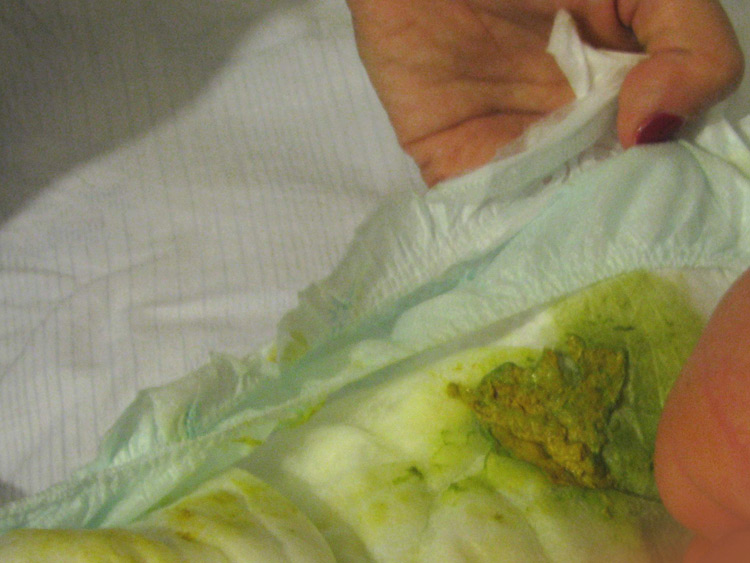
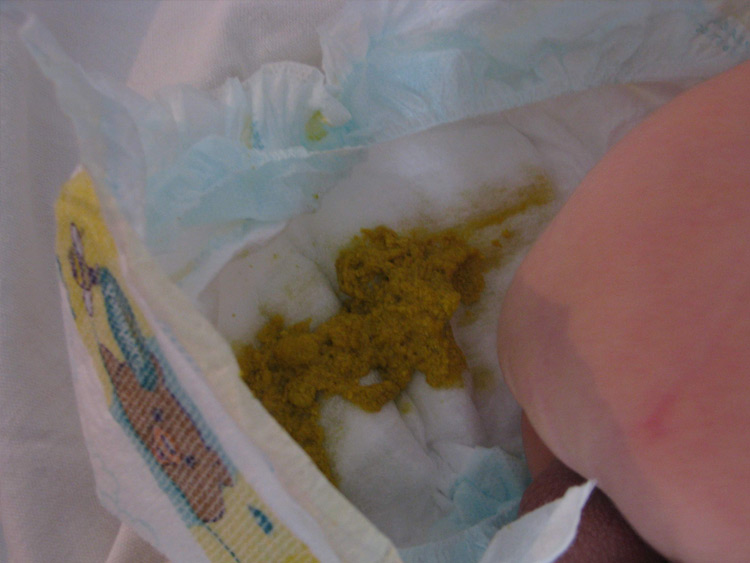

The influence of the nutrition of a nursing mother
The baby's stool can turn green and become liquid if there are drastic changes in the mother's diet. Mom should introduce new foods into her menu very carefully. You should eat fully, paying attention to the cooking process. Spicy, fried and fatty foods in the diet of moms can affect the stool of breastfeeding crumbs. A nursing mother should get protein from lean meat, dairy products, poultry and fish. Cow's milk (whole) should not be consumed in large quantities, as it is an allergenic product.
Mom's diet should include dietary fiber from vegetables and fruits. At the same time, red and orange fruits are recommended to be avoided. A nursing mother should not eat exotic fruits.
An excess of fermenting foods in the mother's diet causes frothy stools in the baby. That is why a nursing woman should consume less sugary drinks, grapes, confectionery.
Symptoms for Anxiety
Be sure to pay attention and go with the baby to the doctor if any of the following symptoms join the green color of the stool:
- Temperature rise;
- Vomit;
- Blood and a significant amount of mucus in the stool - we advise you to read the article about green stools in a child with mucus;
- The frequency of emptying more than 12 per day;
- Unpleasant (sour or putrid) smell of feces;
- Rash.
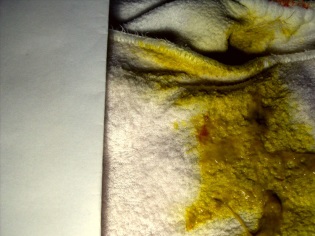 If there is blood in the stool, see a doctor immediately
If there is blood in the stool, see a doctor immediately
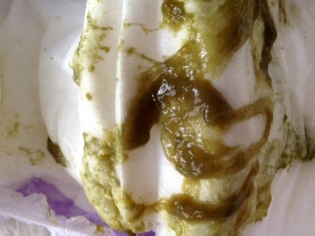 For green stools with mucus, a doctor's consultation is necessary.
For green stools with mucus, a doctor's consultation is necessary.
Possible reasons
Dysbacteriosis
This is not a disease, but a violation of the composition of the flora inside the baby's intestines. The number of bacteria that should normally be less in the intestine increases, and, accordingly, the number of bacteria that should normally prevail decreases.
In babies who receive only breast milk, dysbacteriosis may appear as a result of supplementation. Although in those children who are not given additional water, a state of dysbacteriosis is possible, since the baby's intestines are immature and its flora is only being formed after birth.

lactase deficiency
With such a pathology, the baby's stool is frothy and green. The diagnosis of deficiency of this enzyme is quite rare. More often, stools of this color and consistency indicate that the baby is feeding mainly on fore (watery and liquid) milk.
If the baby's stool was green before, but suddenly began to smell sharply sour and became frothy, this may be evidence of malnutrition of milk from the rear sections of the chest. Such milk is not only more nutritious and contains more fats, but is also a source of enzymes for lactose digestion. The baby may not receive this milk if the mother changed breasts too quickly during suckling, when the baby began to worry.

What to do?
If, in addition to changing the color of the stool, everything is in order with the child (sleep, mood and appetite are normal), just monitor the condition of the baby and, at the first warning signs, take the baby to the pediatrician.
In order for the baby to receive milk from the posterior chamber of the breast, give the baby the breast on demand and do not supplement it so as not to reduce the baby’s desire to suckle the breast. It is also important to ensure that the position of the crumbs when sucking the breast is correct.
If there is a suspicion that the greens in the diaper are provoked by some products on the mother's menu, you should try to exclude them from the mother's diet.
In the first year of life, the child is extremely vulnerable. After all, he just came into this world, and he needs to get used to a lot, get acquainted with various processes. Any mother carefully observes the state of the born little man. And one of the indicators of a baby's health is its stool. Any change in it should alert young parents. A common problem is the predominance of green color in the stool. How should it be normal and what are the reasons for the change? To analyze this, it is necessary to analyze the nutrition of the baby: breastfeeding and artificial.
Green stool while breastfeeding
The child in the first days of his birth has a liquid consistency of feces, called meconium. After about 2 weeks, this indicator in the baby is established and acquires a mushy consistency of yellow-brown color with white patches. Based on this, there are three main factors that characterize the child's chair, which you should pay attention to:
- smell
- consistency
Experts say that a green stool in a baby, even with mucus, is one of the normal options. But this can be considered only if the baby behaves without being capricious. Any change in mood in this condition is a reason to see a doctor.
The most common cause of such changes is the nutrition of the newborn. When breastfeeding, of course, the mother's menu will be the root cause. With milk, the baby is transferred all the substances received by the body of a nursing woman. Therefore, the first thing to do is to analyze this condition. But along with this, you need to know how the digestive system of the crumbs works and the state of his health in general. So why can a baby's stool color turn greenish when breastfeeding? Several factors are noted:
- Mother's nutrition. It is worth the first time to adhere to the general rules for the diet of lactating women. Introduce new products carefully, in small portions. products, causing the appearance squash and cucumbers are considered green in feces.
- Taking medications. Such funds should be selected with great care and under the supervision of the attending physician. The mother's intake of antibiotics has a very large effect on the baby.
- Oxidation processes in air. Remember how you immediately discovered that the child pooped. If some time has passed, it may just be oxidation due to the exposure of the feces to the air. Even the presence of a foamy environment here should not cause concern.
- Excretion of bilirubin along with feces. Which is also the norm of the child's body.

Most often, the matter is managed by revising the mother of her menu. Anything more serious is very rare.
If along with in green a pungent odor is detected, do not hesitate to visit a doctor! There may be another reason behind this.
If violationsstools have a different cause
Fortunately, the vast majority of babies restore normal stools after dietary adjustments. But there are times when it is associated with more serious problems. One of the signs of this will be a violation of the general condition of the baby.Dysbacteriosis is an unbalanced composition of the infant's intestinal flora. The intestines have not yet settled down, it is quite easy to change the number of bacteria in it. Simple supplementation from a bottle with boiled water will bring such a result. Dysbacteriosis is not a disease, but it is necessary to restore the body. The correct appointment will be given by a specialist. Ideally, if the baby is on a natural diet, he receives all the nutrients with his mother's milk. There is no point in giving him water. In addition, he may begin to confuse the breast and the nipple of the bottle. Why? Because the technique of sucking is changing. In some cases, even gradual refusals of the breast were noted.
Lactose deficiency is characterized by a foamy texture. It occurs due to a lack of nutrients in the baby. This is an extremely rare cause and only a good specialist can establish it by prescribing a series of tests. As a rule, this occurs during breastfeeding. If the baby eats only foremilk, less saturated and low-fat. No need to tear him away from the feeding process, he will eat as much as he needs.
Remember the rule, every feeding (approximately 2 - 3 hours) we change the breast. Categorically do not do this when the child is already eating. He must get to the hindmilk, which is hearty and nutritious.

This also occurs due to the fact that the child is not accustomed to eat from the chest. It is likely that in the maternity hospital he was initially introduced to a bottle, from which it is much easier to eat. And having received a breast, he eats only the first milk, which is easier to obtain. Babies with this problem do not gain weight well.
As for artificial nutrition
Parents are more concerned about a change in stool with an artificial type of nutrition. After all, it is believed that here all substances and trace elements are in a balanced state. And often the composition of the mixture is not considered as a reason. Just the opposite. Not every mixture is suitable for babies in composition. This happens because of the high content of iron. The body of each child is individual. Ideally, the brand of the product should be recommended even in the maternity hospital, by knowledgeable specialists. There, tests are taken from the crumbs and, in accordance with this indicator, the selection of the best option is made.
Probably, the mixture did not fit in other parameters, for example, allergies poured out. And there was a change trademark, which coincided with the appearance of a green stool. Analyze this moment. Here you need to consult a competent pediatrician. Fortunately, there is now big choice baby food. Therefore, a knowledgeable doctor should recommend the composition that is right for your baby.
What to do if the stool turns green
Any sane parent will be concerned if the slightest change has occurred in the body of his baby. After all, these crumbs are so small that they are not able to indicate the cause of anxiety in any way. So the first thing to do is to stop panicking. This requires a clear analysis of what is happening and observation. If the mood of the little one remains good, he eats the amount allotted to him, remains cheerful and cheerful, sleeps well - you should not worry. But of course, you need to keep the situation under your vigilant control.
Another thing is if, against the background of a green chair, frequent regurgitation, there is a sharp fetid smell, with sourness, the child is naughty for no reason - urgently go to the doctor. These may be signs of dysbacteriosis that has begun. The consequences are deplorable, especially if diarrhea is added. After all, this is characterized by colossal fluid losses for the child's body.

It happens that mucus and bloody inclusions are added to the stool. It is believed that the reason for this may be an unsettled children's body. But even here, any changes in the behavior of the crumbs should alert you. Therefore, no matter what changes in the stool occur, observe the behavior of the baby. This is the most the right way protect him from danger.
Green stools in infants and newborns can be both normal and a symptom of a bad disease in a child. The frequency, color, smell, consistency of bowel movements - all this is an indicator of the healthy state of the baby.
It is far from always possible to say for sure when such a manifestation is a violation without special studies, and therefore a regular visit to the pediatrician is already half the guarantee of the baby's health.
When is green stool normal?
Green stool does not always mean that the child is not all right. Approximately half of the cases are nothing more than natural processes which in no way affect the development of the baby and his condition.
In a newborn, initially green stools are a must. The fact is that the body gets rid of meconium on the first day - swallowed epithelium, amniotic fluid, etc.On the 3rd - 5th day, transitional changes are noticed.
- At this time, pieces of undigested curdled milk may be found in the feces.
- Gradually the color changes to yellow-green.
- At month old baby normal stools are yellow, closer to mustard.
However, deviations are also allowed. For example, in a newborn, green stools with mucus may indicate that the digestive system is not yet fully coping with the production of enzymes. In addition, bilirubin is excreted from the body along with feces. It stains the chair dark green color.
Nutrition also affects children's stool. Mother's milk contains hormones that affect the baby's feces in a similar way. Much also depends on the products used by the woman.
A child on IV may have a reaction to formula, especially with a high iron content. And in a child of 5 months, a greenish tint may be the result of the introduction of the first complementary foods. In a child of 6 months, the disorder may be associated with the onset.
Symptoms of an unhealthy condition
When should you worry? First of all, monitor the condition of the baby. If he has become lethargic, moody, does not eat well, or his temperature has risen, urgently go to the clinic.
What bowel movements should cause concern for the health of your child?
- green frothy stools with a fetid odor;
- liquid green stools with frequent urge to defecate;
- black-green stools with a putrid odor;
- green stools with mucus, combined with general deterioration of the infant;
- green stools with blood or bloody impurities, especially often this is possible with infants.
A liquid foamy consistency indicates a lack of nutrients. If no infection is detected, the cause is most likely a deficiency of hindmilk. Colostrum stimulates bowel movements, besides, it contains less fat and essential elements for the baby.
If there is an unpleasant odor, consult a doctor immediately, because this may be a signal of an inflammatory process or suppuration. Green stools with blood in a baby can indicate serious problems with the digestive system, damage to the intestinal lining, especially if mucous impurities are present.
You should also pay attention to other signs:
- weakness and drowsiness;
- frequent crying;
- pulling the legs to the tummy;
- pain, discomfort, colic;
- loss of appetite;
- weight loss;
- nausea and;
- diarrhea or constipation;
- temperature;
- rash;
- skin irritation;
- bad breath;
- flatulence and bloating.
If a 3-month-old baby has a similar condition, most likely associated with a violation of the digestive function, in a child at 2 years old this may indicate an infectious disease.
Causes of green stool
Why do such disorders occur? The reasons for the appearance of green stools can be both completely harmless and threaten the health of the baby.
It may be nutrition related. In infants, the digestive system is not yet able to work at full capacity. Therefore, there are difficulties with the digestion of the food consumed.
This is usually indicated by green mucous stools. It may also be due to the selection of an inappropriate mixture. If irritations appear on the pope and genitals of the crumbs, it's not just about the products.
A child of 2 months most often has to deal with. While the intestines have not yet formed the microflora, there is a risk of developing pathogenic bacteria. As soon as the balance returns to normal, the chair will also improve.
Such a problem can be not only in a two-month-old baby. Everyone suffers from dysbacteriosis from time to time. It can develop at 1 year old, and in a child of 5 years old, and in a teenager, and even in an adult.
More serious reasons are:
- infectious diseases, in particular rotavirus and fungal infections;
- helminthic invasion;
- weak immunity;
- congenital pathologies of the gastrointestinal tract;
- stress;
- lactose deficiency;
- allergy;
- enterocolitis, etc.
You should not delay visiting a doctor, since a specific cause can be determined only after passing the tests.
Features of breastfeeding
It is worth separately understanding the features of the nutrition of young children and its effect on bowel movements.
Breastfeeding is considered ideal.
But at the same time, there are a considerable number of restrictions and nuances so that the baby receives all the substances he needs and always feels good.
In the first months, green stools during breastfeeding in the absence of other signs are most often the norm. Many factors can give it such a color. First of all, it concerns hormones.
Also the composition of the diet of a nursing mother can affect children's feces. If a woman eats a lot of green foods, in particular fresh vegetables and fruits, as well as herbs, this contributes to the fact that within a few weeks the child's stool acquires a characteristic shade.
Also, such a reaction may be the result of the use of new products that are not quite suitable for the baby yet. Everything that the mother eats or drinks is inevitably passed on to the baby along with breast milk.
That is why it is recommended to follow a diet during lactation, and also avoid taking hormonal drugs, drugs and antibiotics. In a three-month-old baby, the gastrointestinal tract is still very vulnerable, and therefore supplements based on pro- and prebiotics can be administered to accelerate the formation of a healthy intestinal microflora
A 4-month-old baby may experience this kind of disorder due to premature introduction of complementary foods. Do not give your baby new foods before 5 months.
It is also worth noting that the color and consistency of the stool is affected by the diet, as well as the correct attachment to the chest. If you do not let the baby completely empty the chest and take it away early, he will not receive full-fat milk, but will eat only light fore milk and colostrum. This usually results in the formation of mucus in the stool.
Features of artificial nutrition
At the baby artificial feeding digestive problems are even more common. He experiences difficulties in obtaining all the necessary elements, and therefore the risk of developing dysbacteriosis and weakening of the immune system increases.
In a 2-month-old baby, this condition can be prevented if nutritional mixtures with probiotics and prebiotics are gradually introduced into the diet, as well as prophylactic preparations containing bifidus and lactobacilli. A 4-month-old child needs teas and baby drinks that contain the missing elements and prevent intestinal disorders.
Green stools may appear if the composition of the selected mixture does not suit the baby. In this case, you need to find a more suitable option. Also, a change in the color of feces can occur due to the reaction of iron, which is part of artificial nutrition. This is especially evident in children with lactose disorders.
At one year old baby feces take on the color of eaten food. For example, broccoli or apple puree. Allergies can also develop, so you need to monitor the body's reaction to a particular new product.
Is dysbacteriosis to blame?
In a child of such an early age, dysbacteriosis is an almost inevitable condition. In fact, this is not a disease, but a temporary imbalance in the microflora, but if no measures are taken, the situation can develop into a more serious one.
As soon as you notice violations in the bowel movement, you must immediately go to the clinic and pass. In most cases, it is he who causes the sudden greening of the stool. The child may also experience symptoms such as:
- abdominal discomfort;
- colic;
- diarrhea or constipation;
- general malaise;
- temperature rise;
- nausea;
- slowdown in weight gain.
Green stool in a teenager, newborn or adult in the case of dysbacteriosis is associated with the reproduction of opportunistic microflora and a decrease in the number of bacteria useful for digestion.
Pathological changes
If the matter is not in nutrition and not in dysbacteriosis, most likely the cause of greenish fetid stools was an infection or other pathology. The state of the gastrointestinal tract in such early age unstable, and therefore it can be difficult to notice something is wrong in time and recognize a specific ailment.
Congenital pathologies can cause a change in the color of feces in a newborn and infant digestive system. Depending on the severity, treatment can take place both at home after consulting a specialist, and in a hospital. When there is a threat normal development an infant or serious disorders requiring immediate correction, surgery is possible.
Also, serious causes include various infectious diseases, immune pathologies, disruptions in the endocrine system, etc. Often green stools and abdominal pain indicate. It can also be provoked by staphylococci, salmonella, helminths.
How to help a child

The health of their children is dear to each parent, therefore, if there are violations of the stool, certain measures must be taken to alleviate the condition of the crumbs and bring the situation back to normal.
If the baby is clearly unwell, go to the clinic for tests and a general examination.
It is intended to determine the presence of a violation and its cause.
Using these diagnostic methods, it is also possible to determine the state of the intestinal microflora, to identify the composition of feces, substances that cause specific pigmentation. In addition to microscopic, chemical and bacteriological examinations, doctors also pay attention to macroscopic indicators, namely the consistency, homogeneity, color, the presence of impurities and the frequency of defecation.
Depending on the diagnosis, the doctor will establish a course of treatment and prescribe medication. With dysbacteriosis, special nutritional supplements will be required, which include probiotics and prebiotics. With their help, it is possible to populate the intestines with beneficial bacteria and restore the normal activity of the digestive system. For this purpose, drugs such as:
doctor pays attention
If you do not pay attention to the change in color and consistency of the stool in a small child, this can lead to disastrous consequences. First of all, such a disorder affects the process of healthy formation of the baby's digestive system. With constipation or green, dehydration may occur.
In the presence of pathology, more serious problems can develop. In severe cases, this leads to the spread of inflammation, putrefactive and necrotic processes, up to complete damage to the body.
If your child's health is important to you, never ignore the problem. It is better to visit a doctor once again and make sure that everything is in order than to miss a key moment and lead to pathological changes in a small organism.
With the development of medicine, including its sections related to the bearing and birth of children, the opinion began to sound more and more often that children are born earlier than they should. According to doctors, the organs and systems of newborns are still in great need of intrauterine development with the help of the mother's body.
However, nature was arranged in such a way that children have to grow and develop independently. In the first days after the birth of a child, it is very important to monitor how his body adapts to new living conditions.
One of the main indicators that signal the health of the baby, along with behavior, mobility, and response to the environment, is his feces. For early detection and treatment possible problems health in infants, you need to carefully monitor how and with what the child pooped. Diagnosis of the condition of the baby is carried out on the basis of color, smell and density.
normal stool the baby has a dark green color.
Immediately, in order to eliminate the possible concern of young mothers, it should be noted that there is no fecal sample, looking at which one could say that the child has problems with.
A newly born baby may have feces of an absolutely unpredictable color and consistency. Although some general rules nevertheless exist.
When a baby poops for the first time, his stools should normally be dark green. The first stool is called meconium.
It consists of everything, a digested child that got there during intrauterine development. In the future, the color of the stool changes depending on the type of feeding.
For example, babies fed artificial infant formula have thicker, more homogeneous feces than breastfed babies. Sometimes a change in the color of the stool to green is disturbing.
Most often, there are no deviations. This may be the body's reaction to changes in or depend on the foods eaten. To better understand why the stool turned green, consider this issue in relation to artificial and breastfeeding.
Green feces in babies

The color of feces depends on the type of feeding the baby.
If an infant is breastfed alone, with no added food or formula, his stools will usually be light brown in color.
Usually the feces of the baby are liquid with a sour smell. It will show white blotches.
Quite often, a vessel may burst in the intestines of a newborn, due to which traces may appear in the discharge.
Also, do not worry too much if particles of mucus appear in the diaper. The main causes of green stools in breastfed babies can be:
- Oxidation of food products released after digestion by the body, when they enter the air;
- Staining of feces with foods that the mother of the newborn ate, for example, zucchini or cucumbers;
- Green stool may appear after taking or dietary supplements. Green stools may indicate that the preparation contained iron compounds or antibiotics. In the case of antibiotics, the green color is due to a violation of the microflora of the gastrointestinal tract;
- When the balance of the intestinal flora is disturbed, a condition called. It occurs against the background of an incompletely formed digestive system of an infant. Even with little change diet, or changes to it, the composition and concentration of bacteria in the intestinal flora may change. The infant's body immediately reacts to this by changing the color of the feces to green. There is also nothing to worry about, because even drinking boiled water, in a small amount, for supplementation is already a factor in the appearance of dysbacteriosis;
- When a foamy green stool appears in an infant, the thought immediately arises that lactose deficiency has become the cause. In practice, in the vast majority of cases, everything is much simpler. In order for the nutrition of the baby to be balanced and not disturb the intestinal flora, it is necessary that he receive both anterior and hind breast milk. Failure to comply with this rule leads to the fact that the feces become foamy green. A young mother needs to make sure that the baby completely sucks out her breast, receiving not only the fore, watery, but also the hind, thicker and more nutritious milk. In addition to changing the color of the stool, the use of only foremilk by the infant can lead to the fact that the child will grow poorly and lag behind in weight gain;
Another reason for the appearance of green stools may be the release of bilirubin.
What the color of the chair says, the video will tell:
Green stool in newborns with artificial feeding
In the case of feeding with artificial mixtures, it is easier to understand why the child's feces turned green than with. Indeed, in this case, there is no need to analyze the composition and quality of the mother's nutrition. You just need to look at the composition of the adapted mixture, which is used to feed the baby. If the mixture contains an excess of iron, then the whole point is in it.
By changing the food to a mixture of a different composition, you can get rid of the green color.
Is there a reason for concern?
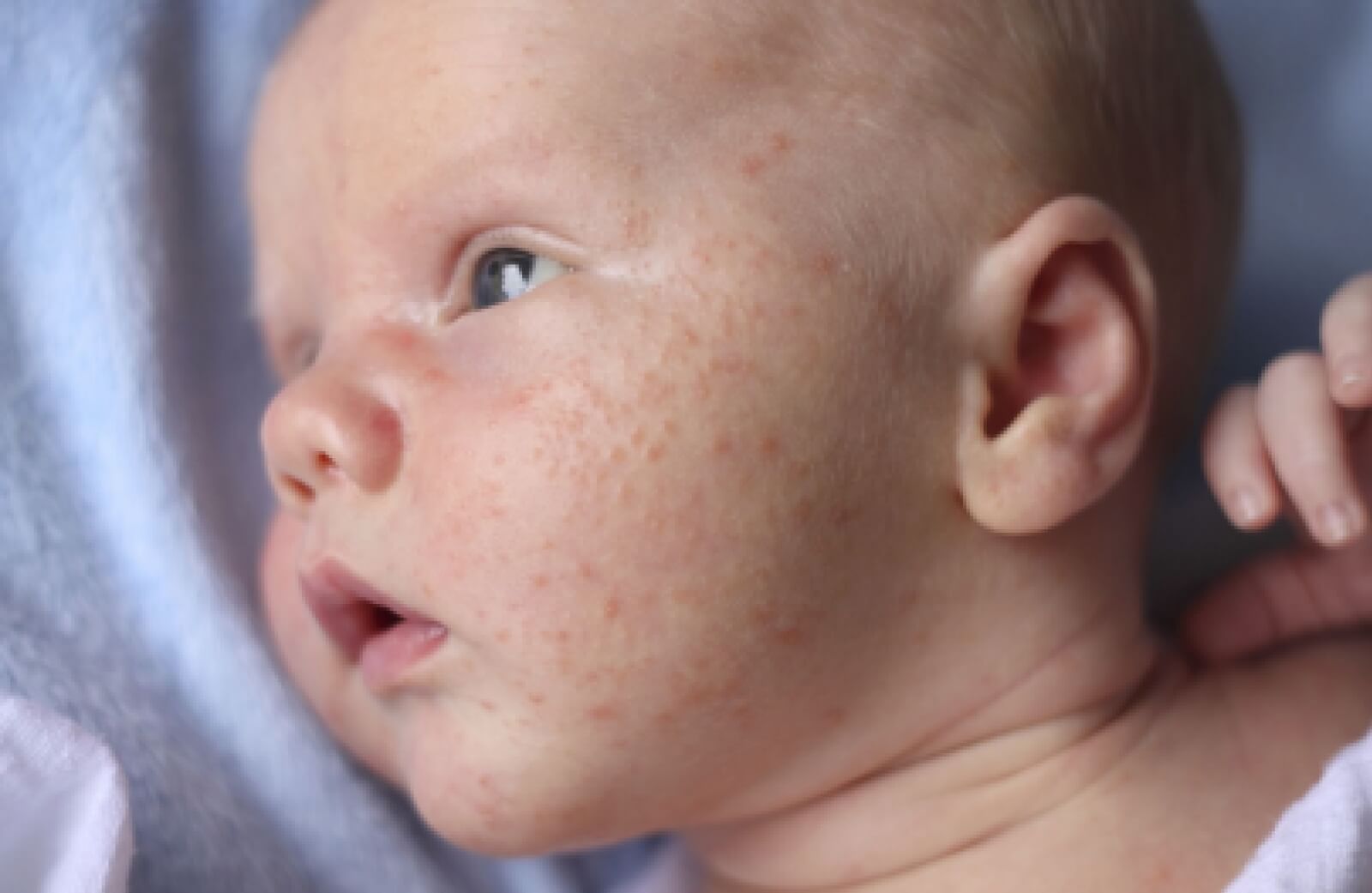
If you have a skin rash, you should contact your pediatrician.
It is by no means impossible to say that a green stool in a newborn indicates problems with it.
Although this may be a signal of a possible disease, but most often, everything is in order. In order to understand whether a child is sick, you need to track his condition in a complex.
The state of health is indicated by how the baby sleeps, whether he eats with appetite, whether he is in a cheerful state, and is not naughty.
If, apart from green traces in the diaper, there are no symptoms of malaise, there is no reason to worry either. You should contact your pediatrician if your child has the following signs diseases:
- skin rashes;
- frequent, unreasonable crying;
- intermittent restless sleep;
- constant spitting up of food;
- increasing number
